Footnotes of 'Mad Men': The Bikini, the Ham, the Firm and His Hooker
by Natasha Vargas-Cooper
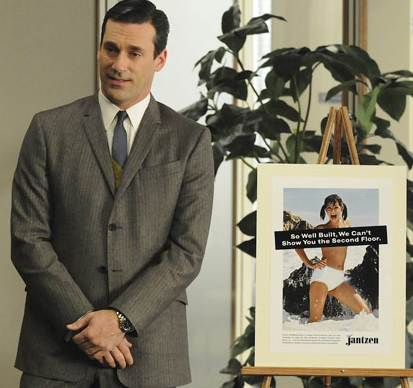
You know what hitting an emotional bottom sounds like? It’s the open palm of a hooker’s hand making contact with stubbly face in a darkened room on Thanksgiving as she joylessly rides you! That’s what it sounds like: slap, slap, slap, welcome to the fall of 1964! This is the moment for which three seasons have prepared us: the cool and muted extended twilight of the Eisenhower patriarchy has at last gone pitch-black.
Decency is being traded in for freedom, divorce, bikinis and soulless PR campaigns used to drum up consumer excitement over something as mundane as congealed canned ham-remember the gals are paid to fight, then they actually do fight, but every one buys more ham. The good news is that with the burgeoning state of kooky consumerism, we have more access to the market and other store-bought (or by-the-hour) indulgences, so it becomes easier to simulate pleasure. The things we buy, the story we tell ourselves and others, is more in our control as the caste system dissolves in a deluge of consumer goods.
Our stories even become commodities. Or to put it more politely, as hero Bert Cooper said, we are “turning creative success into business.”
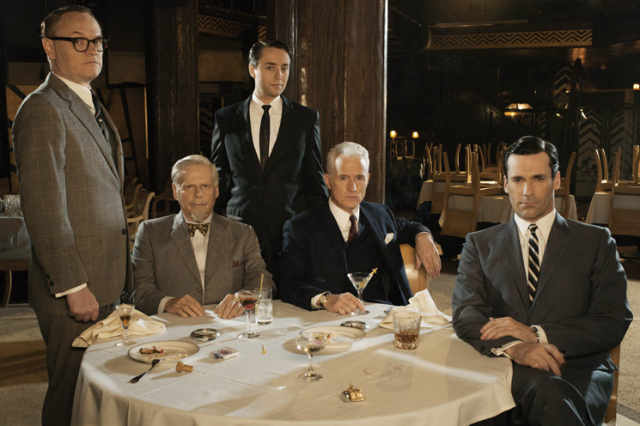
• Selling your self-mythology is a craft. All the ad-men of the golden era (Ogilvy, Lois, Burnett, Daniels) wrote autobiographies. Not only are they all quippy and dishy (they are, after all, creative folks) but the self-made machismo makes them disarmingly charming. You root for each one of these businessmen as if they were saving a village of orphans when really they are selling cigarettes and canned corn. They are always the visionary, always the underdog, always the one with the balls to grab the advertising world by, well, the balls! Here’s my favorite, as told by Draper Daniels about Leo Burnett:
By now everyone in advertising must have heard the story of the friends who sneered and told Leo [when he gave the news he was starting his own company] he’d be selling on apples on the street corner in six months. Undaunted, Burnett replied, ‘the hell I will. I’ll give them away.’ If you haven’t heard it before, you have now, and you know why there’s a bowl of apples in every Burnett reception room.
Who knows if this story is even true? To date, the firm has spent zillions of dollars to have fresh apples in each of their offices.

• Stan Freberg, another ad man/personality (question: where is our favorite rebel with Wellesian scowl and beard, Paul Kinsey?) popped up on the show. The “John! Marshaaaa?” bit that Peggy and her new dreamy art boy keep doing is from a soap opera satire that Freberg released on a comedy album-first as a single, later in compilation.
Freberg also popularized the “abnormal” and “absurd” radio commercial. Ad Age named Freberg one of top 100 most influential men of all time. You can trace the Bud Lite Real Men of Genius commercials and the Old Spice commercials to this one quirky Jew and his microphone! (Update: Or so you might think! “Freberg” is Swedish, and his father was a minister.)
• Don’s Glo-Coat commercial comes from a real life campaign.
You can see the difference in tone between the pre-revolutionary style of the light-hearted, virtue-heavy spot that aired in the late 1950s, featuring housewives and families gliding across a slick floor to the homespun, narrative simulated by Loretta Lynn. This comes from the notion that a compelling story behind the product will make people will want in, even if it’s utterly phony.
The thinking goes, if you put a sign up that says FREE KITTENS, maybe a person or two will pick up a pussycat. Put up a sign that says FREE AMISH KITTENS and they’ll all have homes before sunset.
• Bikinis: score one for freedom over decency! Here’s an example of the chaste image the family men of Jantzen were looking for from 1964. Here’s Sears for Jantzen.
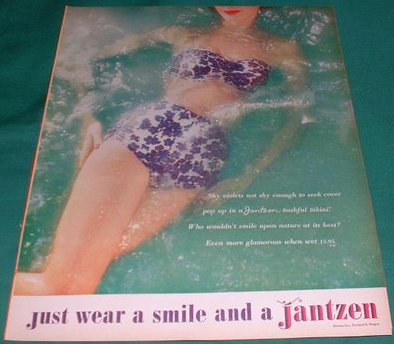
Don’s implied topless ad-which featured photography instead of illustration (miss you, big gay Sal)-could have come from a fashion world scandal that rocked 1964: THE TOPLESS BIKINI.
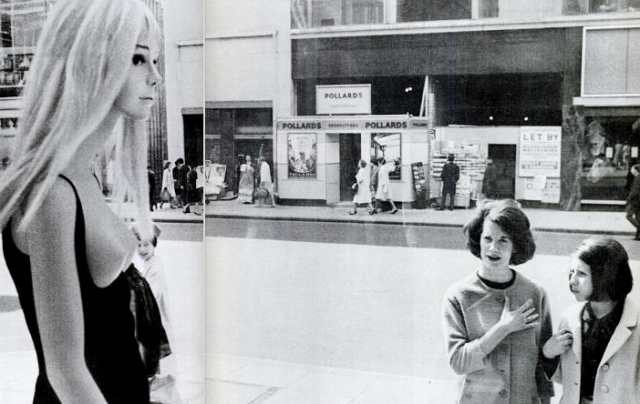
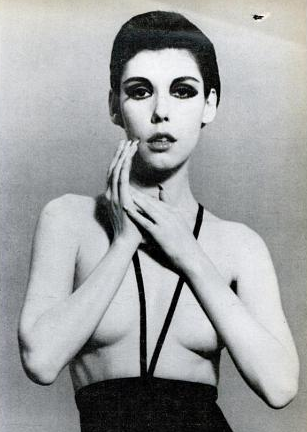
On the runways of Paris, designer (and Mattachine Society co-founder!) Rudi Gernreich and his model Peggy Moffitt debuted a bathing suit with a bikini bottom and straps that went up over your shoulders and that’s all, folks! Breasts, fully exposed. “Once you get over the shock,” a writer for Life magazine said of the suit in July, 1964, “which takes about ten minutes, the new suit begins to strike you as the most absurd garment since those two rascally weavers manufactured the emperor’s new clothes.” It’s no good for swimming, or sunbathing because of “disastrous straps.” The bare-breasted suit was only good for “connoisseurs of pop art, for aficionados of the absurd, and especially for a high fashioned laugh. (One funny thing about toplessness is that it doesn’t really have to do with breasts. Breasts of course are not absurd; topless swimsuits are. Lately people keep getting the two things mixed up.)”
The difference between the image and the authentic are going to remain mixed up for a very long time. Though we all know now that the real difference between a bikini and underwear is just what we call it.
Previously: The Footnotes of ‘Mad Men’
Natasha Vargas-Cooper is the author of Mad Men Unbuttoned
. You can always find more footnotes here.
